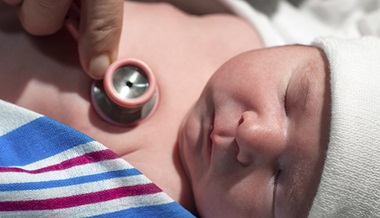Surgery for Pulmonary Atresia with VSD for Children
What is surgery for pulmonary atresia with VSD for children?
Pulmonary atresia is a condition in which the heart is missing a pulmonary valve. This surgery improves blood flow through the heart and out to the lungs.
The heart has 4 chambers: 2 upper (atria) and 2 lower (ventricles). Normally, the right ventricle pumps blood that is low in oxygen through the pulmonary valve to the lungs, where it picks up more oxygen. The heart valves help the blood flow in the correct way through the heart’s 4 chambers and out into the body. The pulmonary valve opens when the heart contracts. Blood can then flow forward into the lungs.
In pulmonary atresia, the pulmonary valve doesn’t form right. So there is no link between the right ventricle and the pulmonary artery. As a result, only a little blood can get to the lungs through an extra blood vessel called the ductus arteriosus. Instead of going to the lungs, blood that is low in oxygen travels through a hole in the wall between the right and left atrium. That causes the blood going out to the body to be very low in oxygen. This lack of oxygen can lead to a number of symptoms.
Some children with pulmonary atresia may also have a hole between the walls of the ventricles. It’s called a ventricular septal defect (VSD).
The type of surgery used to fix pulmonary atresia with VSD varies depending on other problems that are present. Sometimes, surgeons can fix the problem with only one surgery. In these cases, the surgeon creates an opening between the right ventricle and pulmonary artery. He or she then places a tube (conduit) there and closes the hole. In other cases, the surgeon might first fix the opening between the right ventricle and pulmonary arteries. The hole between the ventricles may be closed in a later surgery.
Why might my child need surgery for pulmonary atresia with VSD?
No one knows what causes pulmonary atresia with VSD. The severity can vary based on the anatomy involved. But the condition always needs surgery. Infants may look blue because of the decreased amount of oxygen reaching the body. They may also breathe quickly and have problems breathing.
Your child’s healthcare provider will carefully study your child’s heart before deciding on the best type of surgery. If possible, he or she will likely choose to do the repair in a single surgery. Ask your child’s healthcare provider about which procedure or surgery makes the most sense for your child.
What are the risks of surgery for pulmonary atresia with VSD for a child?
Many children do well with surgery to fix pulmonary atresia with VSD. But complications can develop. Specific risk factors may vary based on your child’s overall health and the condition of his or her heart. Ask your child’s healthcare provider about the particular risks for your child. Possible risks include:
- Excess bleeding
- Infection
- Blood clot, which can lead to stroke or other problems
- Abnormal heart rhythm
- Heart block, which can make a pacemaker necessary
- Complications from anesthesia
Often the child will need follow-up surgeries or catheterization procedures later on. It doesn’t matter what kind of repair the healthcare provider does at first.
How can I help my child get ready for surgery for pulmonary atresia with VSD?
Ask your child’s healthcare provider about how to help your child get ready for the surgery. Your child may need supportive care with extra medicine, oxygen, and sometimes ventilator care. Your child may need to stop taking certain medicines beforehand. He or she should not eat or drink anything after midnight before the day of the surgery.
Your child’s healthcare provider may want some extra tests before the surgery. These might include:
- Chest X-ray
- Electrocardiogram, to look at heart rhythm
- Blood tests, to check general health
- Echocardiogram, to look at heart anatomy and blood flow through the heart
- Heart catheterization, to better look at the coronary blood vessels or blood vessels in the lungs, or to measure the pressures in the heart and lungs
- Cardiac CT or MRI, to better see the lung blood vessels
What happens during surgery for pulmonary atresia with VSD for a child?
Talk with your child’s healthcare provider about what to expect during the surgery. The details of your child’s surgery will vary based on the kind of repair. In general:
- A healthcare provider will give your child anesthesia before the surgery starts. Your child will sleep deeply and painlessly during the operation. He or she won’t remember it afterward.
- The repair will take several hours.
- Your child’s vital signs will be closely watched during the procedure.
- The surgeon makes a cut (incision) down the middle of your child’s chest. He or she will separate the breastbone to reach the heart.
- Your child will be attached to a heart-lung machine. This machine will act as your child’s heart and lungs during the procedure.
- The surgeon may use a patch to enlarge the outflow part of the right ventricle and the valve area. In some cases, the surgeon may replace the valve with a cadaver donor valve.
- In some cases, the surgeon will also fix the hole between the left and right ventricles. Or the surgeon might do this in a later procedure.
- The surgeon will do other surgical repairs as needed.
- Once all the repairs have been done and the heart is beating again, the heart-lung machine will be removed.
- The breastbone will be put back together with wires.
- The muscle and the skin incisions will be closed. A bandage will be applied.
What happens after surgery for pulmonary atresia with VSD for a child?
Ask your child’s healthcare provider about what to expect. In general, after your child’s surgery:
- Your child may be groggy and disoriented when he or she wakes up.
- Your child’s vital signs, such as heart rate, breathing, blood pressure, and oxygen levels, will be closely watched.
- Your child will feel some soreness. But he or she shouldn’t feel severe pain. Pain medicines are available if needed.
- Your child may be able to drink the day after surgery. Your child can have regular foods as soon as he or she can handle them.
- Your child will probably have to stay in the hospital for a week or more.
After your child leaves the hospital:
- Be sure to keep all follow-up appointments.
- Talk with your child’s healthcare provider about what sort of activity and diet are right for your child.
- Call your child’s healthcare provider if your child has fever, increased draining from the wound, or any severe symptoms.
- Follow all the instructions you are given.
Your child might need to take antibiotics before certain medical or dental procedures. That will help prevent an infection of the heart valves. Some children may also need to take medicine to prevent blood clots.
Your child will need follow-up care from a cardiologist after the surgery. Many children with pulmonary atresia with VSD do quite well. But follow-up surgery or other procedures may be needed.
Next steps
Before you agree to the test or the procedure for your child make sure you know:
- The name of the test or procedure
- The reason your child is having the test or procedure
- What results to expect and what they mean
- The risks and benefits of the test or procedure
- When and where your child is to have the test or procedure
- Who will do the procedure and what that person’s qualifications are
- What would happen if your child did not have the test or procedure
- Any alternative tests or procedures to think about
- When and how will you get the results
- Who to call after the test or procedure if you have questions or your child has problems
- How much will you have to pay for the test or procedure





